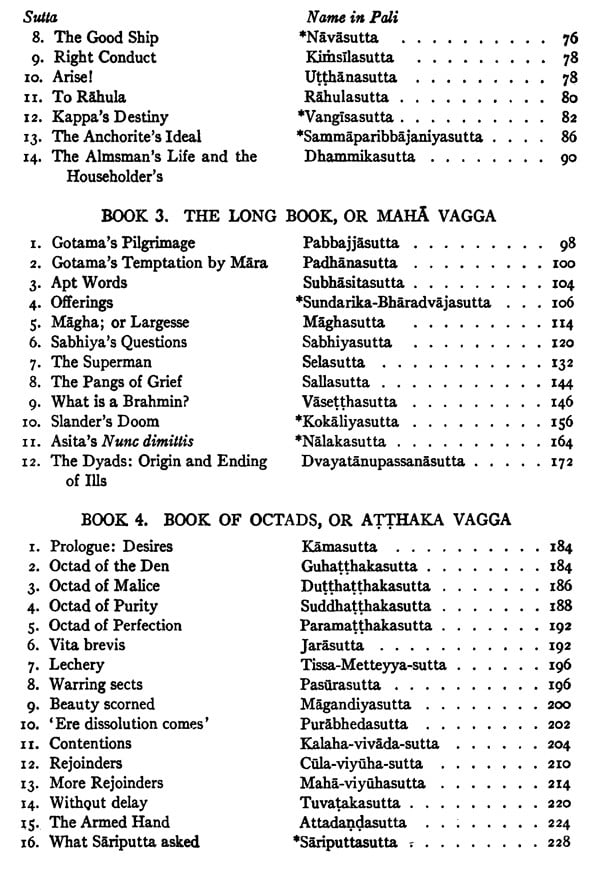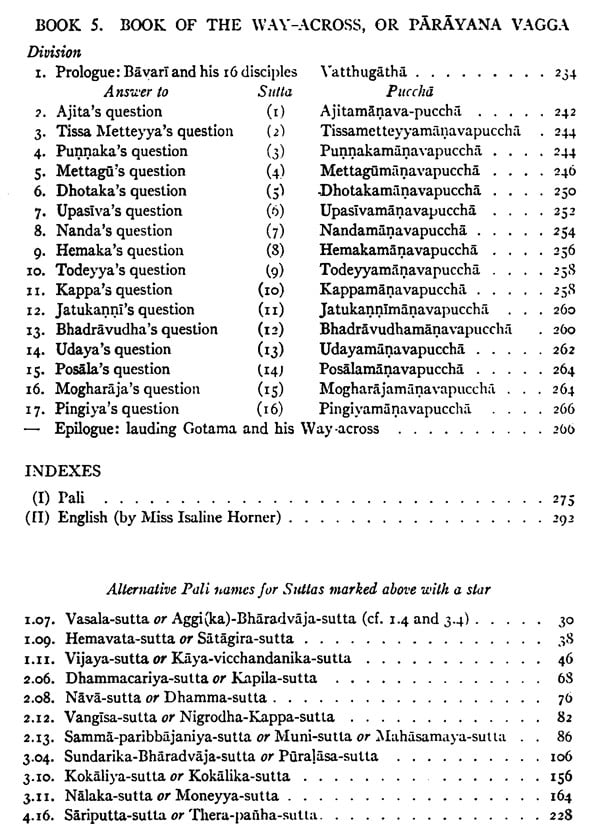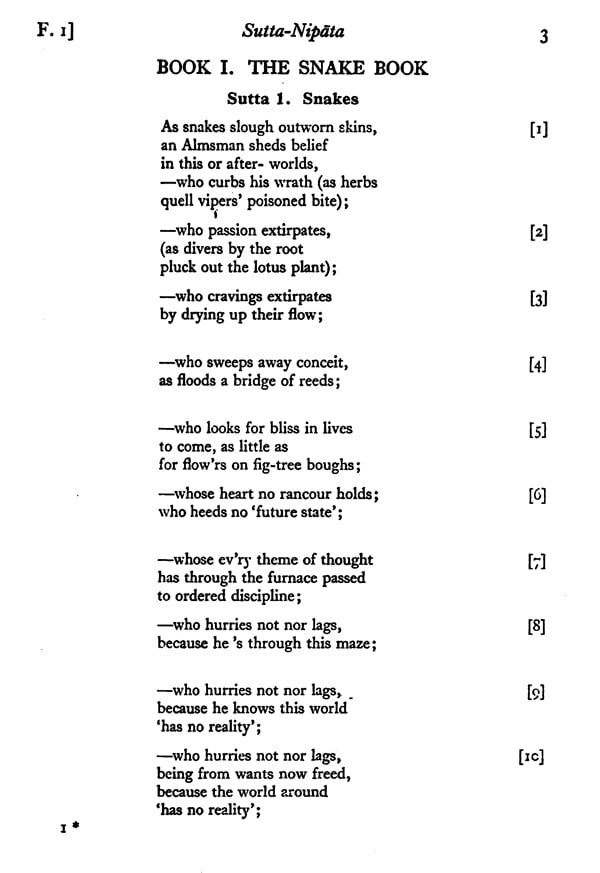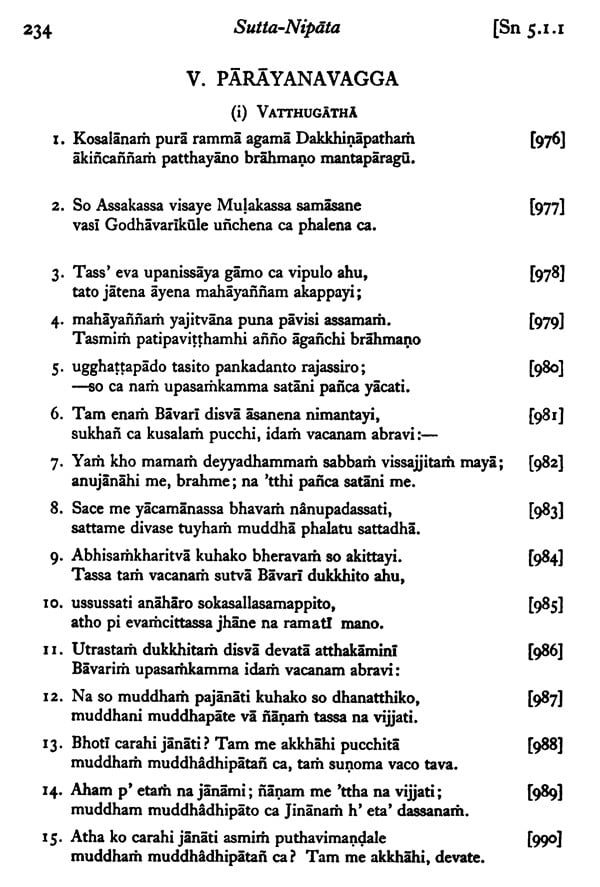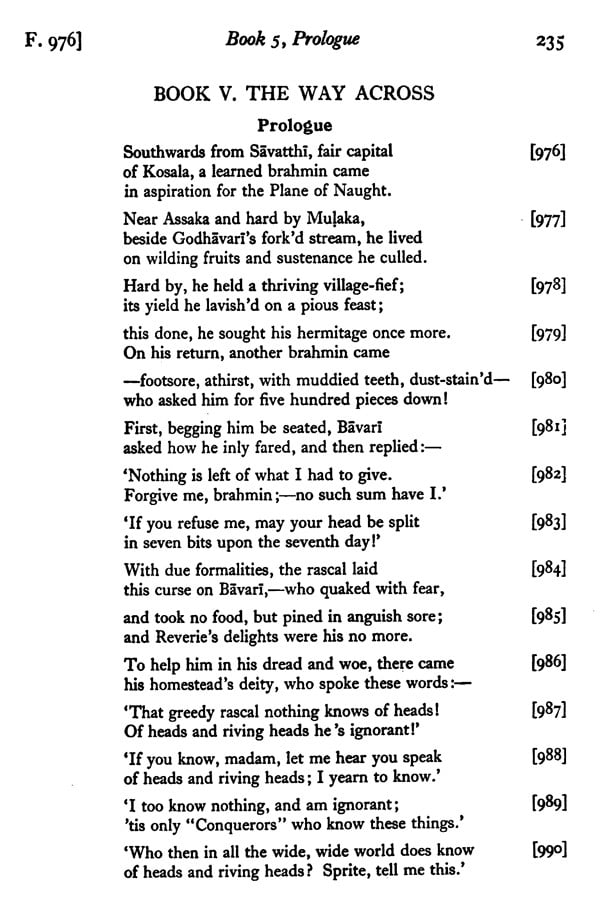
Buddha's Teachings: Being the Sutta-Nipata or Discourse-Collection
Book Specification
| Item Code: | IDC117 |
| Author: | Lord Chalmers |
| Publisher: | Motilal Banarsidass Publishers Pvt. Ltd |
| Language: | English |
| Edition: | 1997 |
| ISBN: | 9788120813557 |
| Pages: | 322 |
| Cover: | Hardcover |
| Other Details | 9.5" X 6.5" |
| Weight | 560 gm |
Book Description
Buddha's Teachings contains a metrical English rendering of an important Buddhist work in Pali named 'Sutta-Nipata' with the original text in Romanized version on the opposite page.
The Pali Canon, as it has come down to us, is divided into three Pitakas or 'baskets', viz. Vinaya-Pitaka, Sutta-Pitaka and Abhidhamma-Pitaka.
The Sutta-Nipata, translated here, contains an ancient, probably the most ancient, part of the Sutta-Pitaka. It belongs to that portion of the Sutta-Pitaka which is named Khuddaka Nikaya or 'Collection of short Treatises' as distinct from the four long Nikayas called Digha, Majjhima, Samyutta and Anguttara.
Of the five Vaggas (or 'books') of the present Sutta-Nipata the fifth stands out from it fellows by reason of its purposeful unity. While the Uraga, Maha, Cula and Atthaka Vaggas consist each of a collection of independent and unconnected poems (sometimes interspersed with prose) called Suttas, the Parayana aims at a dramatic synthesis. Its prologue and epilogue serve as a setting to the sixteen Questions which elicit Gotama's gradual exposition of the saving 'Way Across'.
Preface
Some time ago, when reading the Sutta-Nipata, I was led to the conclusion that, while all verse when translated should receive a metrical rendering, it was particularly desirable to make the attempt here, so as to emphasize in English the historically significant varieties of versification found in the Pali. In 1928 Professor Lanman suggested that, with a Pali text on the opposite page (as in the Loeb Classics), my metrical experiment should find a place in the Harvard Oriental Series. This volume is the outcome of his suggestion.
My Pali text has been based on Fausboll's edition princes of 1885 and on the 'new edition' of 1913 for the Pali Text Society (by Andersen and Helmer Smith),-as modified by the subsequent P.T.S. editions of the Commentary on the Sutta-Nipata (Para-matthajotika II) and of the canonical Niddesa. The conclusion borne in on me was that, apart from minor matters and a very few real divergences of readings, the text of the Sutta-Nipata (thanks to this distinguished parampara of Danish scholars) was practically now a textus receptus; and that, in a volume which is primarily intended for English readers, it was unnecessary to discuss various readings which Pali scholars can readily investigate in the authorities quoted above. Where I have differed, I have aimed at the restoration, not at the conjectural emendation, of the text.
Nor, in the matter of interpretation of the text, have I thought it desirable to cumber the translation with polemic notes or with a record of other's renderings. I have therefore confined myself to an examination (in the Introduction) into the literary evolution of the Sutta-Nipata, so far as it can be traced to-day, and will let the version speak for itself as a commentary no less than as a rendering .
My conclusion is that, while its materials are by no means all of equal antiquity, there is no older book in Buddhist literature than the Sutta-Nipata, and no earlier corpus of primitive Buddhist doctrine that it contains.
While the presence of the Pali on the opposite page forbids exuberance in translation, the limitations of metre (and I have sought to make the English follow roughly the Pali scheme of versification) make it no easy matter-even without rhyme-to compress terse Pali into a relatively modest compass in English. Ignoscent experti.
From the Jacket
Buddha's Teachings contains a metrical English rendering of an important Buddhist work in Pali named 'Sutta-Nipata' with the original text in Romanized version on the opposite page.
The Pali Canon, as it has come down to us, is divided into three Pitakas or 'baskets', viz. Vinaya-Pitaka, Sutta-Pitaka and Abhidhamma-Pitaka.
The Sutta-Nipata, translated here, contains an ancient, probably the most ancient, part of the Sutta-Pitaka. It belongs to that portion of the Sutta-Pitaka which is named Khuddaka Nikaya or 'Collection of short Treatises' as distinct from the four long Nikayas called Digha, Majjhima, Samyutta and Anguttara.
Of the five Vaggas (or 'books') of the present Sutta-Nipata the fifth stands out from it fellows by reason of its purposeful unity. While the Uraga, Maha, Cula and Atthaka Vaggas consist each of a collection of independent and unconnected poems (sometimes interspersed with prose) called Suttas, the Parayana aims at a dramatic synthesis. Its prologue and epilogue serve as a setting to the sixteen Questions which elicit Gotama's gradual exposition of the saving 'Way Across'.
Preface
Some time ago, when reading the Sutta-Nipata, I was led to the conclusion that, while all verse when translated should receive a metrical rendering, it was particularly desirable to make the attempt here, so as to emphasize in English the historically significant varieties of versification found in the Pali. In 1928 Professor Lanman suggested that, with a Pali text on the opposite page (as in the Loeb Classics), my metrical experiment should find a place in the Harvard Oriental Series. This volume is the outcome of his suggestion.
My Pali text has been based on Fausboll's edition princes of 1885 and on the 'new edition' of 1913 for the Pali Text Society (by Andersen and Helmer Smith),-as modified by the subsequent P.T.S. editions of the Commentary on the Sutta-Nipata (Para-matthajotika II) and of the canonical Niddesa. The conclusion borne in on me was that, apart from minor matters and a very few real divergences of readings, the text of the Sutta-Nipata (thanks to this distinguished parampara of Danish scholars) was practically now a textus receptus; and that, in a volume which is primarily intended for English readers, it was unnecessary to discuss various readings which Pali scholars can readily investigate in the authorities quoted above. Where I have differed, I have aimed at the restoration, not at the conjectural emendation, of the text.
Nor, in the matter of interpretation of the text, have I thought it desirable to cumber the translation with polemic notes or with a record of other's renderings. I have therefore confined myself to an examination (in the Introduction) into the literary evolution of the Sutta-Nipata, so far as it can be traced to-day, and will let the version speak for itself as a commentary no less than as a rendering .
My conclusion is that, while its materials are by no means all of equal antiquity, there is no older book in Buddhist literature than the Sutta-Nipata, and no earlier corpus of primitive Buddhist doctrine that it contains.
While the presence of the Pali on the opposite page forbids exuberance in translation, the limitations of metre (and I have sought to make the English follow roughly the Pali scheme of versification) make it no easy matter-even without rhyme-to compress terse Pali into a relatively modest compass in English. Ignoscent experti.
From the Jacket
Buddha's Teachings contains a metrical English rendering of an important Buddhist work in Pali named 'Sutta-Nipata' with the original text in Romanized version on the opposite page.
The Pali Canon, as it has come down to us, is divided into three Pitakas or 'baskets', viz. Vinaya-Pitaka, Sutta-Pitaka and Abhidhamma-Pitaka.
The Sutta-Nipata, translated here, contains an ancient, probably the most ancient, part of the Sutta-Pitaka. It belongs to that portion of the Sutta-Pitaka which is named Khuddaka Nikaya or 'Collection of short Treatises' as distinct from the four long Nikayas called Digha, Majjhima, Samyutta and Anguttara.
Of the five Vaggas (or 'books') of the present Sutta-Nipata the fifth stands out from it fellows by reason of its purposeful unity. While the Uraga, Maha, Cula and Atthaka Vaggas consist each of a collection of independent and unconnected poems (sometimes interspersed with prose) called Suttas, the Parayana aims at a dramatic synthesis. Its prologue and epilogue serve as a setting to the sixteen Questions which elicit Gotama's gradual exposition of the saving 'Way Across'.
Preface
Some time ago, when reading the Sutta-Nipata, I was led to the conclusion that, while all verse when translated should receive a metrical rendering, it was particularly desirable to make the attempt here, so as to emphasize in English the historically significant varieties of versification found in the Pali. In 1928 Professor Lanman suggested that, with a Pali text on the opposite page (as in the Loeb Classics), my metrical experiment should find a place in the Harvard Oriental Series. This volume is the outcome of his suggestion.
My Pali text has been based on Fausboll's edition princes of 1885 and on the 'new edition' of 1913 for the Pali Text Society (by Andersen and Helmer Smith),-as modified by the subsequent P.T.S. editions of the Commentary on the Sutta-Nipata (Para-matthajotika II) and of the canonical Niddesa. The conclusion borne in on me was that, apart from minor matters and a very few real divergences of readings, the text of the Sutta-Nipata (thanks to this distinguished parampara of Danish scholars) was practically now a textus receptus; and that, in a volume which is primarily intended for English readers, it was unnecessary to discuss various readings which Pali scholars can readily investigate in the authorities quoted above. Where I have differed, I have aimed at the restoration, not at the conjectural emendation, of the text.
Nor, in the matter of interpretation of the text, have I thought it desirable to cumber the translation with polemic notes or with a record of other's renderings. I have therefore confined myself to an examination (in the Introduction) into the literary evolution of the Sutta-Nipata, so far as it can be traced to-day, and will let the version speak for itself as a commentary no less than as a rendering .
My conclusion is that, while its materials are by no means all of equal antiquity, there is no older book in Buddhist literature than the Sutta-Nipata, and no earlier corpus of primitive Buddhist doctrine that it contains.
While the presence of the Pali on the opposite page forbids exuberance in translation, the limitations of metre (and I have sought to make the English follow roughly the Pali scheme of versification) make it no easy matter-even without rhyme-to compress terse Pali into a relatively modest compass in English. Ignoscent experti.

